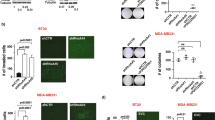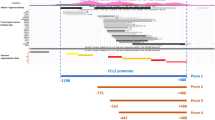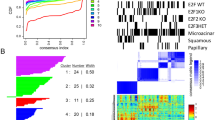Abstract
Expression of the chemokine receptor CXCR4 has been linked with increased metastasis and decreased clinical prognosis in breast cancer. The current paradigm dictates that CXCR4 fosters carcinoma cell metastasis along a chemotactic gradient to organs expressing the ligand CXCL12. The present study asked if alterations in autocrine CXCR4 signaling via dysregulation of CXCL12 in mammary carcinoma cells modulated their metastatic potential. While CXCR4 was consistently detected, expression of CXCL12 characteristic of human mammary epithelium was silenced by promoter hypermethylation in breast cancer cell lines and primary mammary tumors. Stable re-expression of functional CXCL12 in ligand null cells increased orthotopic primary tumor growth in the mammary fat-pad model of tumorigenesis. Those data parallel increased carcinoma cell proliferation measured in vitro with little-to-no-impact on apoptosis. Moreover, re-expression of autocrine CXCL12 markedly reduced metastatic lung invasion assessed using in vivo bioluminescence imaging following tail vein injection. Consistent with those data, decreased metastasis reflected diminished intracellular calcium signaling and chemotactic migration in response to exogenous CXCL12 independent of changes in CXCR4 expression. Together these data suggest that an elevated migratory signaling response to ectopic CXCL12 contributes to the metastatic potential of CXCR4-expressing mammary carcinoma cells, subsequent to epigenetic silencing of autocrine CXCL12.
This is a preview of subscription content, access via your institution
Access options
Subscribe to this journal
Receive 50 print issues and online access
$259.00 per year
only $5.18 per issue
Buy this article
- Purchase on Springer Link
- Instant access to full article PDF
Prices may be subject to local taxes which are calculated during checkout








Similar content being viewed by others
References
Agace WW, Amara A, Roberts AI, Pablos JL, Thelen S, Uguccioni M et al. (2000). Constitutive expression of stromal derived factor-1 by mucosal epithelia and its role in HIV transmission and propagation. Curr Biol 10: 325–328.
Amara A, Gall SL, Schwartz O, Salamero J, Montes M, Loetscher P et al. (1997). HIV coreceptor downregulation as antiviral principle: SDF-1alpha-dependent internalization of the chemokine receptor CXCR4 contributes to inhibition of HIV replication. J Exp Med 186: 139–146.
Balkwill F . (2004). The significance of cancer cell expression of the chemokine receptor CXCR4. Semin Cancer Biol 14: 171–179.
Baylin SB, Chen WY . (2005). Aberrant gene silencing in tumor progression: implications for control of cancer. Cold Spring Harb Symp Quant Biol 70: 427–433.427–433.
Brauweiler A, Merrell K, Gauld SB, Cambier JC . (2007). Cutting Edge: acute and chronic exposure of immature B cells to antigen leads to impaired homing and SHIP1-dependent reduction in stromal cell-derived factor-1 responsiveness. J Immunol 178: 3353–3357.
Clark SJ, Harrison J, Molloy PL . (1997). Sp1 binding is inhibited by (m)Cp(m)CpG methylation. Gene 195: 67–71.
Dewan MZ, Ahmed S, Iwasaki Y, Ohba K, Toi M, Yamamoto N . (2006). Stromal cell-derived factor-1 and CXCR4 receptor interaction in tumor growth and metastasis of breast cancer. Biomed Pharmacother 60: 273–276.
Ellison G, Klinowska T, Westwood RF, Docter E, French T, Fox JC . (2002). Further evidence to support the melanocytic origin of MDA-MB-435. Mol Pathol 55: 294–299.
Garcia-Moruja C, Alonso-Lobo JM, Rueda P, Torres C, Gonzalez N, Bermejo M et al. (2005). Functional characterization of SDF-1 proximal promoter. J Mol Biol 348: 43–62.
Gazitt Y . (2004). Homing and mobilization of hematopoietic stem cells and hematopoietic cancer cells are mirror image processes, utilizing similar signaling pathways and occurring concurrently: circulating cancer cells constitute an ideal target for concurrent treatment with chemotherapy and antilineage-specific antibodies. Leukemia 18: 1–10.
Heidemann J, Ogawa H, Dwinell MB, Rafiee P, Maaser C, Gockel HR et al. (2003). Angiogenic effects of interleukin 8 (CXCL8) in human intestinal microvascular endothelial cells are mediated by CXCR2. J Biol Chem 278: 8508–8515.
Herman JG, Baylin SB . (2003). Gene silencing in cancer in association with promoter hypermethylation. N Engl J Med 349: 2042–2054.
Hesselgesser J, Liang M, Hoxie J, Greenberg M, Brass LF, Orsini MJ et al. (1998). Identification and characterization of the CXCR4 chemokine receptor in human T cell lines: ligand binding, biological activity, and HIV-1 infectivity. J Immunol 160: 877–883.
Jenkins DE, Hornig YS, Oei Y, Dusich J, Purchio T . (2005). Bioluminescent human breast cancer cell lines that permit rapid and sensitive in vivo detection of mammary tumors and multiple metastases in immune deficient mice. Breast Cancer Res 7: R444–R454.
Kimura R, Nishioka T, Ishida T . (2003). The SDF1-G801A polymorphism is not associated with SDF1 gene expression in Epstein-Barr virus-transformed lymphoblastoid cells. Genes Immun 4: 356–361.
McGarvey KM, Fahrner JA, Greene E, Martens J, Jenuwein T, Baylin SB . (2006). Silenced tumor suppressor genes reactivated by DNA demethylation do not return to a fully euchromatic chromatin state. Cancer Res 66: 3541–3549.
Moyer RA, Wendt MK, Johanesen PA, Turner JR, Dwinell MB . (2007). Rho activation regulates CXCL12 chemokine stimulated actin rearrangement and restitution in model intestinal epithelia. Lab Invest 87: 807–817.
Muller A, Homey B, Soto H, Ge N, Catron D, Buchanan ME et al. (2001). Involvement of chemokine receptors in breast cancer metastasis. Nature 410: 50–56.
Nagasawa T, Hirota S, Tachibana K, Takakura N, Nishikawa S, Kitamura Y et al. (1996a). Defects of B-cell lymphopoiesis and bone-marrow myelopoiesis in mice lacking the CXC chemokine PBSF/SDF-1. Nature 382: 635–638.
Nagasawa T, Nakajima T, Tachibana K, Iizasa H, Bleul CC, Yoshie O et al. (1996b). Molecular cloning and characterization of a murine pre-B-cell growth-stimulating factor/stromal cell-derived factor 1 receptor, a murine homolog of the human immunodeficiency virus 1 entry coreceptor fusin. Proc Natl Acad Sci USA 93: 14726–14729.
Orimo A, Gupta PB, Sgroi DC, Arenzana-Seisdedos F, Delaunay T, Naeem R et al. (2005). Stromal fibroblasts present in invasive human breast carcinomas promote tumor growth and angiogenesis through elevated SDF-1/CXCL12 secretion. Cell 121: 335–348.
Phillips RJ, Burdick MD, Lutz M, Belperio JA, Keane MP, Strieter RM . (2003). The stromal derived factor-1/CXCL12-CXC chemokine receptor 4 biological axis in non-small cell lung cancer metastases. Am J Respir Crit Care Med 167: 1676–1686.
Rhee I, Bachman KE, Park BH, Jair KW, Yen RW, Schuebel KE et al. (2002). DNMT1 and DNMT3b cooperate to silence genes in human cancer cells. Nature 416: 552–556.
Rot A, von Andrian UH . (2004). Chemokines in innate and adaptive host defense: basic chemokinese grammar for immune cells. Annu Rev Immunol 22: 891–928.
Salvucci O, Bouchard A, Baccarelli A, Deschenes J, Sauter G, Simon R et al. (2006). The role of CXCR4 receptor expression in breast cancer: a large tissue microarray study. Breast Cancer Res Treat 97: 275–283.
Schrader AJ, Lechner O, Templin M, Dittmar KE, Machtens S, Mengel M et al. (2002). CXCR4/CXCL12 expression and signalling in kidney cancer. Br J Cancer 86: 1250–1256.
Shirozu M, Nakano T, Inazawa J, Tashiro K, Tada H, Shinohara T et al. (1995). Structure and chromosomal localization of the human stromal cell-derived factor 1 (SDF1) gene. Genomics 28: 495–500.
Smith JM, Johanesen PA, Wendt MK, Binion DG, Dwinell MB . (2005). CXCL12 activation of CXCR4 regulates mucosal host defense through stimulation of epithelial cell migration and promotion of intestinal barrier integrity. Am J Physiol Gastrointest Liver Physiol 288: G316–G326.
Smith MC, Luker KE, Garbow JR, Prior JL, Jackson E, Piwnica-Worms D et al. (2004). CXCR4 regulates growth of both primary and metastatic breast cancer. Cancer Res 64: 8604–8612.
Tachibana K, Hirota S, Iizasa H, Yoshida H, Kawabata K, Kataoka Y et al. (1998). The chemokine receptor CXCR4 is essential for vascularization of the gastrointestinal tract. Nature 393: 591–594.
Ueda Y, Neel NF, Schutyser E, Raman D, Richmond A . (2006). Deletion of the COOH-terminal domain of CXC chemokine receptor 4 leads to the down-regulation of cell-to-cell contact, enhanced motility and proliferation in breast carcinoma cells. Cancer Res 66: 5665–5675.
Wendt MK, Johanesen PA, Kang-Decker N, Binion DG, Shah V, Dwinell MB . (2006). Silencing of epithelial CXCL12 expression by DNA hypermethylation promotes colonic carcinoma metastasis. Oncogene 25: 4986–4997.
Zeelenberg IS, Ruuls-Van Stalle L, Roos E . (2003). The chemokine receptor CXCR4 is required for outgrowth of colon carcinoma micrometastases. Cancer Res 63: 3833–3839.
Zou YR, Kottmann AH, Kuroda M, Taniuchi I, Littman DR . (1998). Function of the chemokine receptor CXCR4 in haematopoiesis and in cerebellar development. Nature 393: 595–599.
Acknowledgements
We thank Dr Richard Komorowski (Department of Pathology, Medical College of Wisconsin) and Dr Eric Luedke for assistance in obtaining and processing primary human mammary carcinoma tissue and Dr Robert Truitt (Cancer Center of the Medical College of Wisconsin and Director of the Biophotonic Imaging Core) for assistance in these studies. These studies were supported in part by grants from the Cancer Center of the Medical College of Wisconsin and the American Cancer Society (IRG-84-004).
Author information
Authors and Affiliations
Corresponding author
Additional information
Supplementary Information accompanies the paper on the Oncogene website (http://www.nature.com/onc).
Supplementary information
Rights and permissions
About this article
Cite this article
Wendt, M., Cooper, A. & Dwinell, M. Epigenetic silencing of CXCL12 increases the metastatic potential of mammary carcinoma cells. Oncogene 27, 1461–1471 (2008). https://doi.org/10.1038/sj.onc.1210751
Received:
Revised:
Accepted:
Published:
Issue Date:
DOI: https://doi.org/10.1038/sj.onc.1210751
Keywords
This article is cited by
-
High density of CXCL12-positive immune cell infiltration predicts chemosensitivity and recurrence-free survival in ovarian carcinoma
Journal of Cancer Research and Clinical Oncology (2023)
-
CXCR4 and its ligand CXCL12 display opposite expression profiles in feline mammary metastatic disease, with the exception of HER2-overexpressing tumors
BMC Cancer (2018)
-
Glyceollins trigger anti-proliferative effects through estradiol-dependent and independent pathways in breast cancer cells
Cell Communication and Signaling (2017)
-
A meta-analysis of CXCL12 expression for cancer prognosis
British Journal of Cancer (2017)
-
Cancer cell chemokines direct chemotaxis of activated stellate cells in pancreatic ductal adenocarcinoma
Laboratory Investigation (2017)



